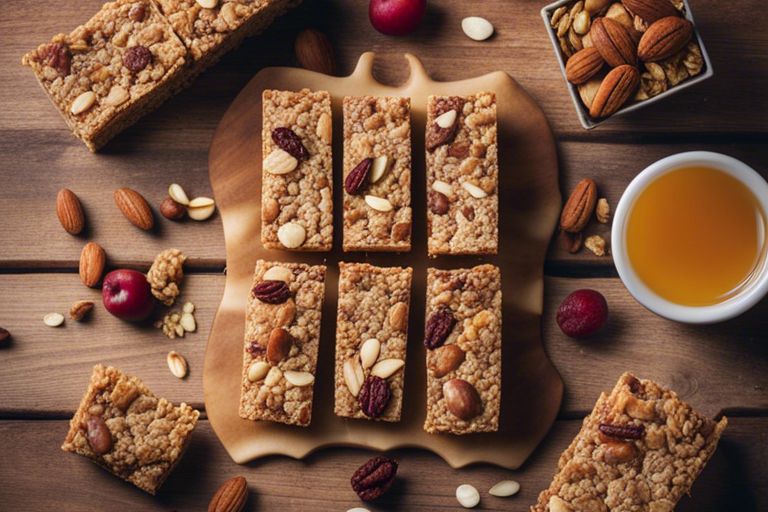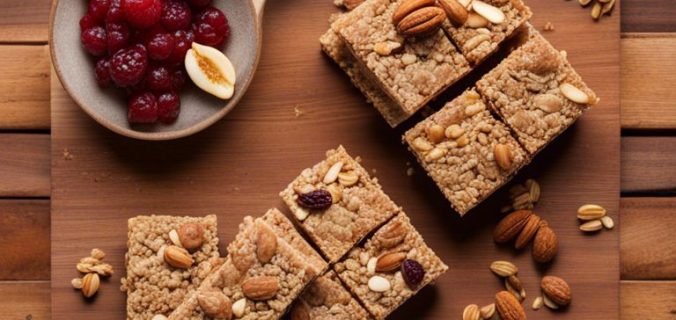Upcycle your spent grain into delicious granola bars with this simple recipe. By utilizing the nutritious byproduct of brewing, you can create a wholesome treat that is not only sustainable but also packed with fiber and protein. Follow these easy steps to transform what would typically be discarded into a delightful snack that is perfect for on-the-go energy. Let’s get started!
Key Takeaways:
- Reduce Food Waste: Using spent grain from brewing to make granola bars helps reduce food waste by repurposing a byproduct of the brewing process.
- Environmentally Friendly: Upcycling spent grain into granola bars is a sustainable and environmentally friendly way to utilize resources and reduce carbon footprint.
- Nutritious Snack: These upcycled granola bars are not only eco-friendly but also a nutritious snack option, providing fiber, protein, and other crucial nutrients.
Understanding Spent Grain
What is Spent Grain?
Before you probe making upcycled granola bars from spent grain, you need to understand what spent grain actually is. Spent grain is the byproduct of the beer-making process where grains such as barley, wheat, or oats are soaked in hot water to extract sugars for fermentation. Once the sugars are extracted, the remaining grain is what’s called spent grain.
Benefits of Using Spent Grain in Granola Bars
Using spent grain in your granola bars not only adds a unique flavor and texture but also reduces food waste. Spent grain is high in fiber and protein, making it a nutritious addition to your snacks. Incorporating spent grain into your granola bars can also be a sustainable choice as it gives a second life to a byproduct that would otherwise be disposed of.
When you use spent grain in your granola bars, you are adding depth of flavor and a chewy texture that can elevate your snack game. Not only are you getting the benefits of a homemade granola bar, but you are also contributing to the environment by reducing waste.
Preparing Spent Grain for Upcycling
There’s nothing quite like the satisfaction of upcycling spent grain from your homebrewing process to make delicious granola bars. To start the upcycling process, you’ll need to prepare the spent grain properly.
Drying and Storing Spent Grain
Drying: After brewing your beer, spread the spent grain out on baking sheets in a thin layer and dry it in the oven at a low temperature. Once the spent grain is completely dried, you can move on to the next step in the upcycling process.
Grinding Spent Grain into Flour
Flour: Grinding dried spent grain into flour is a crucial step in making upcycled granola bars. You can use a food processor or blender to grind the dried spent grain into a fine flour-like consistency. This flour will be the base for your delicious granola bars.
Grain: Keep in mind that the texture and flavor of your granola bars will heavily depend on how finely you grind the spent grain. Make sure to grind it to a consistency that works well for your recipe and desired taste and texture of the granola bars.

Essential Ingredients for Upcycled Granola Bars
Not sure what ingredients you need to make delicious upcycled granola bars from spent grain? In this chapter, we’ll cover the imperative components you’ll need to create these tasty and sustainable treats.
Binding Agents: Honey, Peanut Butter, and More
With honey, peanut butter, and other binding agents, you can ensure that your granola bars hold together well. These ingredients not only help the bars maintain their shape but also add sweetness and a rich flavor. You can experiment with different types of nut butters, such as almond butter or cashew butter, to give your bars a unique taste.
Nutritious Add-ins: Nuts, Seeds, and Dried Fruits
If you want to add a nutritional boost to your upcycled granola bars, consider incorporating nuts, seeds, and dried fruits. These add-ins not only provide extra flavor and texture but also offer imperative nutrients like protein, fiber, and antioxidants. You can choose from a variety of options such as almonds, walnuts, chia seeds, flaxseeds, dried cranberries, or raisins to tailor your bars to your liking.
Peanut butter, a common binding agent in granola bars, also serves as a nutritious ingredient due to its protein content. It adds a rich and creamy texture to the bars while offering a boost of energy. When combined with nuts, seeds, and dried fruits, peanut butter creates a well-balanced snack that will keep you satisfied and fueled throughout your day.
Tips for Perfecting Your Granola Bar Recipe
To create the perfect batch of upcycled granola bars from spent grain, consider the following tips:
- Experiment with different types of oats, grains, and chia seeds. Each ingredient can impact the texture of your granola bars, so try using a combination of rolled oats, spent grain, and chia seeds to find the right balance.
- Adjust the sweetness and saltiness levels according to your taste preferences. Play around with the amount of honey and salt in your recipe until you achieve the perfect balance of flavors.
- Add unique spices and flavorings to customize your granola bars. Cinnamon, vanilla extract, or nutmeg can add depth and complexity to your bars.
Assume that with a bit of experimentation and tweaking, you’ll discover the ideal granola bar recipe that suits your taste buds perfectly.
Factors Affecting Texture: Oats, Grains, and Chia Seeds
To achieve the perfect texture in your granola bars, consider the impact of oats, grains, and chia seeds:
- Oats: Rolled oats will provide a chewier texture, while quick oats can make your bars softer.
- Grains: Spent grain can add a nutty flavor and some crunch to your bars.
- Chia Seeds: Incorporating chia seeds can add a gel-like texture and boost the nutritional value of your bars.
Knowing how each of these ingredients contributes to the overall texture will help you tailor your recipe to achieve the desired consistency.
Balancing Sweetness and Saltiness
You can customize the sweetness and saltiness of your granola bars to suit your preferences. Start by using honey or maple syrup as natural sweeteners and a pinch of salt to enhance the flavors in your bars. Adjust the amounts until you find the perfect balance of sweet and salty.
Customizing with Spices and Flavorings
While the base ingredients for granola bars are necessary, you can elevate the flavor profile by incorporating spices and flavorings. Experiment with cinnamon, nutmeg, vanilla extract, or almond extract to add depth and complexity to your bars.
Another way to customize your granola bars is by adding dried fruits, nuts, or seeds for extra texture and flavor. Be mindful of the quantities to maintain the perfect balance of ingredients in your bars.
How to Mix and Shape Your Granola Bars
Once again, if you want to learn more about how ReGrained Granola Bars Are Made From Spent Beer Grain, you can check out this article on Food Republic.
Combining Wet and Dry Ingredients
Any successful granola bar starts with the combination of wet and dry ingredients. Mix your spent grain (dry ingredient) with nuts, seeds, dried fruits, and spices in a large bowl. In a separate bowl, combine honey, nut butter, and vanilla extract, and then pour this wet mixture over the dry ingredients. Stir together until well combined and all the dry ingredients are coated evenly.
Pressing and Shaping Bars for Easy Snacking
Bars for easy snacking are made by pressing the mixture firmly into a parchment-lined baking dish. Use another piece of parchment paper to press down firmly on the mixture to create a dense and compacted bar. Once the mixture is evenly flattened, place the baking dish in the refrigerator for at least an hour to allow the bars to set. After that, you can use a sharp knife to cut the mixture into individual bars. Enjoy your homemade granola bars as a convenient and sustainable snack option.
With these simple steps, you can create your own delicious and nutritious granola bars using spent grain. Remember to experiment with different combinations of ingredients to find the perfect flavor profile that suits your taste preferences. Making your own granola bars not only reduces food waste but also allows you to customize your snacks according to your dietary needs and flavor preferences. So, get creative in the kitchen and enjoy the satisfaction of making your own upcycled granola bars.
Baking and Cooling Your Granola Bars
Temperature and Time: Getting it Just Right
For the perfect granola bars, it’s vital to bake them at the right temperature for the right amount of time. To help you achieve optimal results, refer to the following table:
| Temperature | Time |
|---|---|
| 325°F (163°C) | 20-25 minutes |
By following this guideline, you will ensure that your granola bars are perfectly baked, with a crunchy texture and rich flavor.
Cooling and Cutting for Freshness and Convenience
Even after you take your granola bars out of the oven, the baking process continues as they cool down. This is an important step not to rush, as it allows the bars to set properly and develop their final texture.
Getting the cooling and cutting right is crucial for the freshness and convenience of your granola bars. Once they have cooled completely, gently cut them into bars of your desired size using a sharp knife. This will help you to store them easily and grab a delicious snack on the go.
To wrap up
Now that you have learned how to make upcycled granola bars from spent grain, you can enjoy a delicious snack while also reducing food waste. By following the simple steps outlined in this guide, you can transform leftover brewing grains into a tasty treat that is perfect for on-the-go snacking or a quick breakfast. Not only are you creating a sustainable snack option, but you are also saving money by utilizing ingredients that might otherwise be thrown away.
Q: What is spent grain?
A: Spent grain is a byproduct of the beer-brewing process. After the grains have been used to make beer, they are no longer needed and are often discarded. However, spent grain can be repurposed and used in various recipes, such as granola bars.
Q: How do you prepare spent grain for use in granola bars?
A: To prepare spent grain for use in granola bars, you first need to dry it out. This can be done by spreading the spent grain out on a baking sheet and baking it at a low temperature until it is completely dry. Once the spent grain is dry, you can then incorporate it into your granola bar recipe.
Q: Are there nutritional benefits to using spent grain in granola bars?
A: Yes, there are nutritional benefits to using spent grain in granola bars. Spent grain is high in fiber and protein, which can help keep you feeling full and satisfied. Additionally, using spent grain in recipes helps reduce food waste, making it a more sustainable choice for both your diet and the environment.

